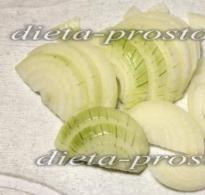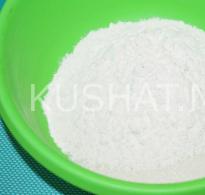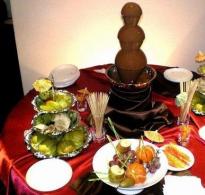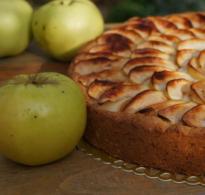Classic Chateaubriand steak: history and recipe.
Fried meat is considered one of the very first dishes that man has prepared in his history. Hundreds of centuries have passed since those times, but still juicy, fragrant and satisfying piece of fire-fried meat remains one of the most respected and desired foods in any part of the world. Of course, during all this time the recipe has undergone many changes. Now he has his own specific cooking technology, he has acquired new, more exquisite tastes and aromas. Today, there are several types of steaks. And if you are looking for a main dish for romantic dinner, the Chateaubriand steak would be one of the best options.
Steak means "to fry"
It is customary to cook a true steak on open fire. If you have a grill in your home, then mastering the art of cooking steaks is simply vital for you. It would seem, what could be easier than frying a piece of meat? But in fact, this task is not an easy one. And not every professional chef will be able to cook a steak correctly. To achieve perfection, you have to practice. To begin with, learn how to choose meat for a particular type of steak. Choose the optimal and harmonious ratio of spices and, of course, master the technology of the degree of roasting. Traditionally, it is customary to cook Chateaubriand, but it is recommended to make it from bull meat. Remember that even quality product, frozen will be significantly inferior in taste fresh meat Therefore, try to buy it on the day of cooking.
The main thing is the right meat
All steaks differ from each other in only one thing - the part of the carcass of the animal from which the tenderloin is made. "Chateaubriand" - a steak that is prepared from the extreme, thickest part of the tenderloin, located closer to the tail of the animal. This piece has an irregular shape, and therefore it is more difficult to cook than any other steak. It is important that the inner part has several degrees of roasting at once. The top crust should be well-done and securely hold all the juices inside. This is what, according to the French aristocracy, the Chateaubriand steak should be.

Preparing the tenderloin
This type of steak is cooked in one large piece and served in the same way. Ready meat can be cut into portioned pieces just before serving. Usually one piece of tenderloin is enough for two servings of a dish like Chateaubriand. The steak is cut along or across the fibers, there are no clear rules in this.
After you have washed and dried the meat from excess moisture, it must be carefully cleaned of films. In places where veins are visible, shallow cuts should be made. So, the meat will not lose its shape during frying. Then rub your future Chateaubriand steak with spices. The recipe, which is considered to be a classic, suggests using only a mixture of salt and black pepper. And now you can grease the meat vegetable oil and put on a hot grill.
Roast degree matters
There are several types of roasting meat, and you can use the one that suits you best. The classic Chateaubriand steak has a well-fried crust. The next layers should be in varying degrees of doneness, from "full" at the edges to "rare" towards the center. Inside, such a steak should have a thin vein of completely raw meat. If you don't really like "rare" meat, then you can hold the steak on the fire a little longer so that it is not raw inside.

First you need to fry the prepared tenderloin on a grill heated to 250 degrees. Fry a piece for 20 seconds on each side. So a crust forms on the surface, thanks to which the juices will be held inside. Now you need to reduce the temperature to 180-200 degrees and bring the steak to the desired readiness.
It takes about 10-15 minutes to get a rare steak, but 25-30 minutes for a higher degree of doneness. Do not forget to turn the meat over and grease it with vegetable oil to form appetizing crust. The time for each steak will be determined individually, the meat can be different weight and "age".
cooking sauce
The Chateaubriand steak enjoys great respect in many restaurants around the world. This dish is simply impossible to serve without sauce. And this is a great field for your imagination. Any sauce can be served, but it is desirable that it be prepared on an oil basis. This will make your dish even more juicy, and spices and fresh herbs underlined exquisite fragrance and taste.

Traditionally, Chateaubriand is served with french sauce"Bearnaise". To prepare it you will need:
- 3 egg yolks;
- dry white wine - 4 tbsp. l;
- butter- 100 g;
- wine vinegar (white) - 4 tbsp. l;
- shallots - 1 pc.;
- bay leaf, black peppercorns and salt;
- fresh tarragon - 1 bunch.
Put spices, finely chopped onion and tarragon in a saucepan, pour in vinegar and white wine, put on fire. With constant stirring, the contents must be boiled down to half the volume, then removed from the heat and cooled. Now the future sauce needs to be rubbed through a sieve, add raw yolks and put on slow fire. Carefully grind the yolks with a mass until a homogeneous consistency. Then add oil and hold for a little more low fire. The sauce should have a smooth, uniform texture, be fluffy and slightly thick. The classic "Béarnaise" is ready.
"Chateaubriand" can be served with a side dish of vegetables, boiled potatoes or fresh herbs. And of course, do not forget the prepared sauce and a glass of good wine.
Enjoy your meal!
Chateaubriand is gentle and juicy steak from the head of the beef tenderloin, served with traditional sauce"Bearnaise". Usually one steak is enough for two servings, which makes it great option for a romantic dinner. For the first time this steak was prepared by the cook of the Viscount de Chateaubriand, which is why it got its name. Since about the middle of the 19th century, the dish has been firmly entrenched in the menu of French restaurants, and then spread throughout the world.
Cooking:
- Prepare the meat: Place the tenderloin on a cutting board for 15-20 minutes to warm and oxygenate the meat.
- To prepare the Béarnaise sauce, place quartered shallots, 4 sprigs of tarragon, vinegar and white wine in a small saucepan.
- Put everything on a small fire. Boil everything until the volume is reduced to 2 tablespoons of golden liquid. Remove from heat and strain through a sieve.
- Melt the butter in a separate bowl or saucepan (it is important to make sure that it does not boil) and leave to cool. Add black pepper, chopped tarragon and parsley (2 sprigs each) to the oil.
- Whisk in a separate bowl egg yolks by adding a tablespoon ice water. Put the resulting mixture on steam bath and beat until foamy, gradually introducing melted butter.
- Combine both bases and add fresh chopped herbs. Salt to taste.
- Place the steak in a hot and oiled skillet. Fry for 2 minutes on each side until a delicious crust appears - this way you "seal" the juices.
- Then bring the steak to the desired doneness. Medium (10-15 minutes) is considered the best option - in this case, the middle will turn out to be pleasant Pink colour. Remove from skillet and sprinkle with freshly ground pepper and salt.
- Serve steak Chateaubriand with sauce and vegetable garnish.
Bon appetit!
- This gourmet dish For true gourmets. A real meat classic. It is obtained from the thickest part of the beef tenderloin, in which there are no fatty layers and connective tissue. The steak is cooked until rare or medium rare, which conveys the extraordinary juiciness of the meat and its creamy taste.
The history of the dish began in the middle of the 19th century, when the personal chef of Viscount Francois-Rene de Chateaubriand prepared for him. The guests of the viscount liked the dish very much, and after a while the Chateaubriand steak got into the menu of expensive French restaurants. Despite the fact that the Chateaubriand steak is a dish haute cuisine you can always buy beef tenderloin and cook this delicious cut at home!
In order for the finished Chateaubriand steak to be above all praise, we recommend that you strictly follow the recipe and follow the correct temperature regime. But first things first.
Chateaubriand tenderloin has an oblong cylindrical shape and an impressive thickness. The steaks are cut at least 3 cm thick, so some people have difficulty cooking them.
Advice from T-Bone: when you bought a beef tenderloin, do not rush to cook it right there. Tie it with culinary twine or ordinary thread, securing the original shape, and soak for at least a day in the refrigerator, wrapping it in a clean cotton towel.
There are several ways to cook. You can quickly sear the meat in a skillet, constantly turning it over so that it browns on all sides, and then grill it in the oven. Ready meat can be cut into slices and fry each piece on both sides for 30 seconds. Finished tenderloin slices are poured with sauce and served with a side dish. A good option for those who like medium and medium well roasting.
The classic way to cook a Chateaubriand steak is pre-roasting in a frying pan and bring to the desired degree of readiness in the oven. It is very important to control the internal temperature of the meat. Ideally, it should not exceed 55 degrees.
Advice from T-Bone: the meat will acquire new flavors if seasoned with pepper, olive oil, provencal herbs and garlic. But salting the steaks is better at the very end.
Dry- or wet-aged beef does not need to be marinated, tenderized, or hammered. But a simple marinade, in which the meat will lie down for half an hour at most, will not be superfluous.
Classic Chateaubriand steak it will turn out tastier if you marinate it in before frying spicy paste. It is made from butter, herbs and garlic. Chop all ingredients as small as possible. Place the herbs with garlic in a mortar, season with salt and pepper, and grind well. Then add some olive oil, stir and rub the bran with the resulting mixture.
Last tip:
Chateaubriand steak is a lean cut and can be easily dried out. To prevent this from happening, cook it over high heat in a well-heated pan. Fry the meat thoroughly on all sides, constantly turning it over. After the steak is fried on all sides, immediately transfer it to a baking dish, cover with foil (it will prevent the meat from burning) and send it to the oven, heated to 220 degrees. Warm up the steak for literally another 3-5 minutes, and then let the meat “rest” without removing the foil.
It is known that cooking steaks is a real art! A right steaks, especially. Achieving perfection is not easy, even eminent chefs will confirm this. In our material, we will tell you about the most popular steaks around the world.
Steak Chateaubriand.
Chateaubriand is grilled or fried and served with a traditional béarnaise sauce. Restaurants often offer a similar dish called château, with the same side dishes as châteaubriand, such as potatoes.
Story.
Chateaubriand is the French version of the English steak. The author of this dish was the personal chef of the Viscount de Chateaubriand (1768 - 1848) - Montmireil. At that time, the steak was cooked from the sirloin of the carcass and served with a sauce of white wine and shallots, moistened with butter, wormwood and lemon juice. There are rumors that the name refers to the quality of the cattle that lived in the Châteaubriand area. Pellapratut claims that the first restaurant where Chateaubriand was prepared was Champaux.
The process of creating this steak is quite complicated due to its thickness (about 3 cm), it is done slowly so that the steak is cooked from the inside, and not just from the outside.
Neck steak.
Neck, or as it is called differently - shoulder steak - a cutout of beef meat pulp, round-oval-flat, cut across the muscle fibers. A typical steak is a thick cut of beef containing portions of the shoulder bones, and is known as a "7 steak" due to the shape of the bone that resembles the number 7. This steak is typically grilled. A thicker version is cooked in a broth pot. The bone in this steak is very small, which makes this steak one of the "meatiest". In the UK, it is most commonly referred to as " braised steak". It is especially popular as ground meat, due to its richness of flavor and balance of meat and fat.
Boneless steaks are called eye (eye) (boneless cutouts from the center of the neck), fillet, shoulder steak. The usual market cut of meat is cut from the neck and shoulders, but in some markets you can also find meat from the center of the ribs. Short ribs are cut from meat.
Steak contains a large number of connective tissue, including collagen, which partially melts during cooking. Steak meat is usually used for stewing, or roasting in a pot.
 Ribeye steak.
Ribeye steak.
Ribeye, also known as Scotch fillet (in Australia and New Zealand), is a beef steak made from the ribs.
The rib portion of the beef extends from the sixth rib to the twelfth. Rib-eye steak is mainly composed of the muscles of the longissimus dorsi, but also contains the spinous muscle.
Ribeye is the meatiest and most “marbled” steak. It is no coincidence that the level of marbling of the entire carcass is determined precisely by the cut of this steak.
The name ribeye comes from two English words rib-eye - rib and eye. The rib is where the steak comes from, and the eye is the shape of the cross section. The abundance of fatty layers, which melt quickly when frying, makes ribeye the juiciest and most unpretentious in cooking of all steaks. Ribeye is a versatile steak that can be cooked at home in a pan and served as delicacy dish, or you can roast it on coals and eat it at a picnic, sitting on the grass. The ribeye steak is a classic, an indispensable attribute of a good meat restaurant.
Cube steak. 
Cube steak - a cut of beef, rounded on top, softened by blows with a meat mallet, or using electric softeners. Many professional chefs claim that it is better to use specialized cube steak machines instead of hammers.
Minute steak.
In Canada, as well as parts of the United States, the cube steak is known as the minute steak because it can be cooked quickly.
The term "minute steak" is also used in the UK, where the term "cube steak" is not as common.
Flank Steak.
Flank steak - (also known as beef steak), is a steak cut from the abdominal muscle of a cow. Relatively long and flat piece of meat. Steak is used in variety of dishes, including London roast and fajitas. It is significantly tougher than other cuts of beef, which is why many recipes use wet cooking methods such as braising.
The Mexican version of the steak has become famous throughout Latin America. It originates in the city of Monterrey and is known as "arrachera" in mexican food. It can be tenderized with commercial tenderizers, or with mechanical tenderizers, a piece of meat. Another version of arrachera is known as entraña, the difference being that the latter has a thick layer of fat surrounding the muscles, making it juicy. The French are quite partial to this tenderloin, known as "bavette". She quickly fried hot pan to keep your tenderness. Bavette is often served in Parisian bistros with onions - "Bavette l'échalotte". The tenderloin is also popular in Colombia, where it is known as "sobrebarriga", which literally means "above the stomach".
Flank steak is considered good when it has a bright red color. This means that the meat came from strong, healthy cattle fed with quality grain.
Steak is often used in Asian cuisine, and is often sold as "beef roast" in Chinese markets because that is how it is usually prepared. Most beef dishes in Cantonese restaurants are made from these tenderloins.
Flat steak. 
Flat steak is the American name for the tenderloin, also known as "butler" steak in the UK. This is a cut from the shoulder of a cow. The steak consists of the infraspinatus muscle of the cow. Steaks that are made from this muscle are called top steaks or patio steaks. In general, a piece of meat, usually weighs about two or three pounds, it is located next to the heart and has a shoulder blade. The whole cut usually yields four to eight steaks up to 12 ounces each. A flat steak usually has a high level of marbling. This neckline is anatomically different from the padded shoulder neckline that sits directly below it.
Restaurants, especially upscale ones, have recently started adding flat steaks to their menus. Wagyu beef steaks are especially popular. To make it more marketable, the steak is cut into two flat steaks, each corresponding to one muscle, with the tough fascia removed.
 Hanging steak.
Hanging steak.
Hanging steak is prized for its flavor. This is a cut from the diaphragm that typically weighs 1.0 to 1.5 pounds (450 to 675 g). In the past, it was sometimes called "butcher's steak" because butchers often kept it for themselves rather than offering it for sale.
Hanging steak resembles flank steak in texture and flavor. It has a V-shape with a pair of muscles with long, inedible membranes in the middle. The steak is not particularly tender and is best cooked marinated over a high heat (grill or broiler). The steak is usually cut into two separate pieces of meat.
Usually spelled "bistro steak" on the menu, hanging steak is traditional in Mexican cuisine, especially in the north, where it is marinated, fried, and served with lime juice, guacamole, salsa, and tortillas. In South Texas, this beef tenderloin is known as fajitas arajeras.
Hanging steak has historically been more popular in Europe. In the UK it is called a "skirt". In French, it is known as onglet, in Italian lombatello, and in Spanish solomillo de pulmon.
Popeseye steak. 
Popeseye steak is a thinly sliced rump steak produced in Scotland and available in the UK. In fact, it is a gland surrounded by fat in the middle of the thigh of an ox or sheep.
Etymology.
This word is made up of two English words pope and eye. Which respectively mean pop and eye.
Characteristics.
The steak is very tender, and due to its relative thinness compared to other steaks, it cooks quickly, especially if you use a frying pan as a frying pan. This steak should be cooked before it turns brown on each side.
These steaks can be used in the following ways:
Instead of other types of beef steaks, stewed, fried.
As an ingredient in meat pie.
 Ranch Steak.
Ranch Steak.
Ranch steak is a tenderloin from the shoulder part of a cow, namely the shoulder. Technically, it's called a "cut-in-the-middle" steak, but supermarkets usually use the shorter and more memorable term, "ranch steak." A ranch steak is typically cut no thicker than one inch, weighing 10 ounces or less, and is usually trimmed of all excess fat.
Ranch steak tends to be flavorful but a bit tough. top scores achieved when the steak is medium done using dry cooking methods. It's good when stewed, but it's great when grilled.
Round Steak.
Round steak steak from round cuts of beef. Specifically, a round steak may include thigh, knee, and depending on how the meat was separated from the loin. This cut is moderately hard. The low fat and marbling make round steaks ideal for dry cooking. Round steak is usually cooked with slow moist heat methods, including braising, to tenderize the meat and keep it moist.
Dishes:
Bresaola - air-dried salted beef from a round steak.
London roast - usually made from a round steak.
Italian beef is a thinly sliced steak cooked in broth.
Rinderbraten - round steak stuffed pork fat and spices.
Steak Variations:
Ground round or beef mince-type ground beef from a round steak.
Accordion tenderloin - cut alternately on both sides to make a thinner steak.
Butterflying - cutting through the center.
Swiss steak - a series of small cuts with a bladed roller, also called Swissing or tenderizing (softening).
Skirt steak.
Skirt steak - a slice of beef, from the plate. It is a long, flat cut that is valued for its flavor rather than tenderness. Sometimes a flank steak is used along with a skirt steak.
Skirt steak, the boneless part of the diaphragm muscle attached from the 6th to the 12th ribs at the bottom of the curl. This steak is encased in a tough membrane that must be removed before cooking.
Intra-juvenile steak boneless meat is free of fat and membranes.
Usage.
Skirt steak is used to make fajitas, north mexican food arrachera, cornish pies, Chinese roast, Cuban and Puerto Rican churrasco.
To minimize the stiffness of the steak, it is either grilled or pan-fried using very fast or very slow cooking, usually braising. Because of the strong graininess, the steak is cut across the grain for maximum tenderness. They are also often prepared pickled.
Skirt steak is sometimes referred to as Romanian tenderloin in New York restaurants and steakhouses. It is usually grilled or barbecued whole and is often served with fried onions and potatoes or baked beans.
Carpet steak.
Carpetbagger steak is an authentic Australian dish that was first popularized in Sydney around 1950.
It consists of the end of a scotch fillet tenderloin, served standing up like a miniature mountain. Pockets in the meat are made with small cuts into which pieces of oyster are inserted and secured with toothpicks. When the dish is fried, the taste fresh oysters permeates the steak and mixes with the juice of the meat. Bacon strips can also be wrapped around the steak. In the tradition of Sydney, the steak is marinated in a sauce of thyme, pepper, tarragon, lemon, sugar and tamarind and served with a glass dessert wine. The steak can be seared with cognac, then it is called "Carpetbag Maxine style".
To be continued….






